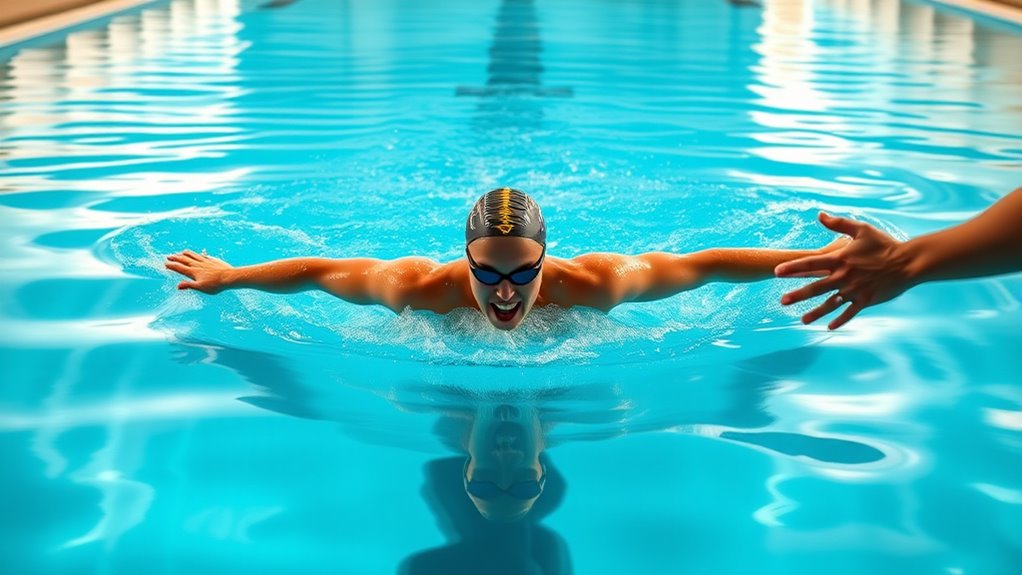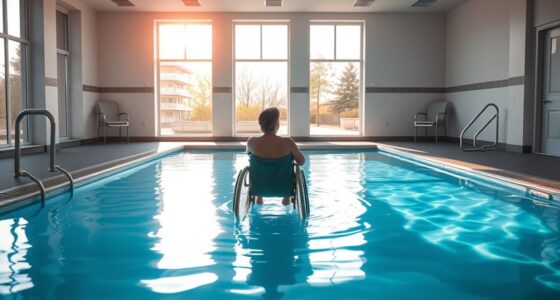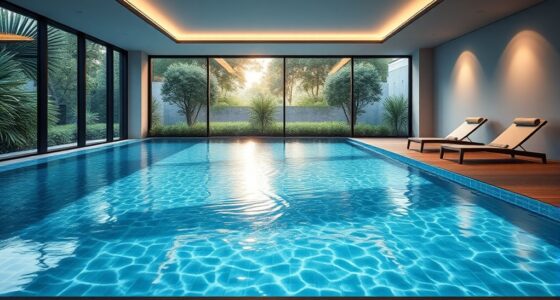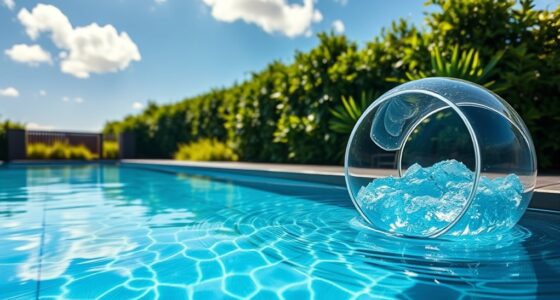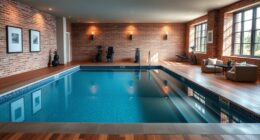To improve your swim technique with endless pool drills, focus on adjusting water flow to match your pace, maintaining proper body position, and practicing controlled breathing. Incorporate drills like single-arm pulls, kick sets, and body alignment exercises to refine your efficiency and reduce resistance. Regularly monitor your progress and adjust intensity to challenge yourself safely. Keep optimizing your routines, and you’ll uncover more effective techniques that help you swim faster and more smoothly.
Key Takeaways
- Adjust water flow and temperature to match your pace, creating resistance and comfort for effective technique practice.
- Focus on body alignment, keeping a streamlined position to reduce drag and improve efficiency during drills.
- Incorporate purposeful drills like single-arm pulls and kick sets to target specific stroke components.
- Monitor performance metrics and sensations to identify areas for technical improvement and adjust training accordingly.
- Regularly evaluate and vary drills to prevent stagnation, ensuring continuous progress in swim technique.
Setting Up Your Endless Pool for Optimal Training
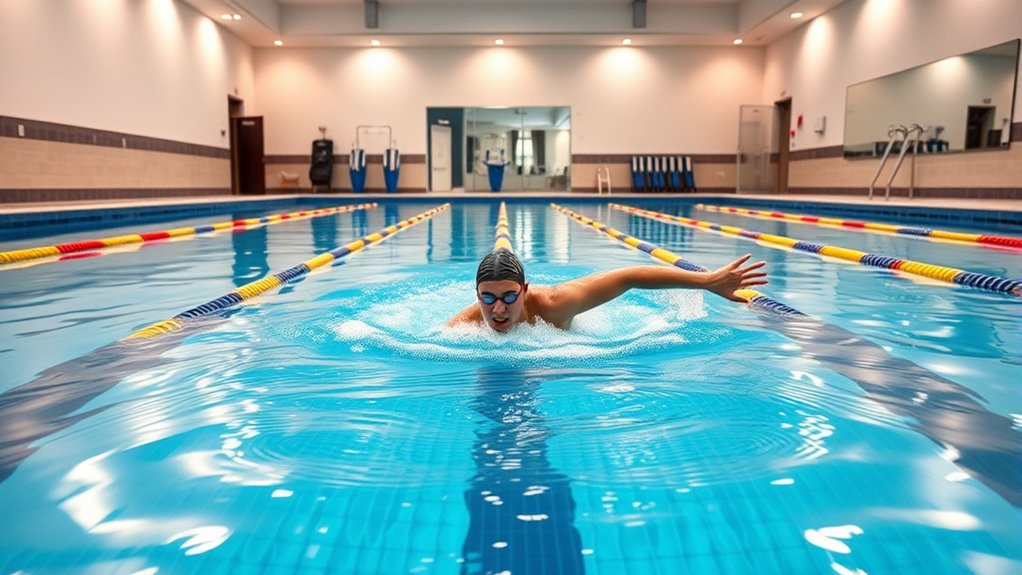
To get the most out of your endless pool training, you need to set it up properly. Start by adjusting the water flow to match your swimming pace, ensuring it provides enough resistance without overwhelming you. Check that the temperature is comfortable—around 78 to 82°F—so you can focus on technique without distraction. Clear the surrounding area of any obstructions, making sure you have enough space to swim freely. Position yourself close to the wall or a designated starting point to maintain consistent starts and turns. Make sure the pool’s filtration system is clean and functioning correctly, as debris or poor circulation can affect water quality. Proper setup creates a smooth, safe environment that enhances your focus and allows you to maximize each training session. Additionally, regularly inspecting the equipment and water quality helps prevent potential system malfunctions that could disrupt your workout.
Designing Effective Drills for Technique Enhancement
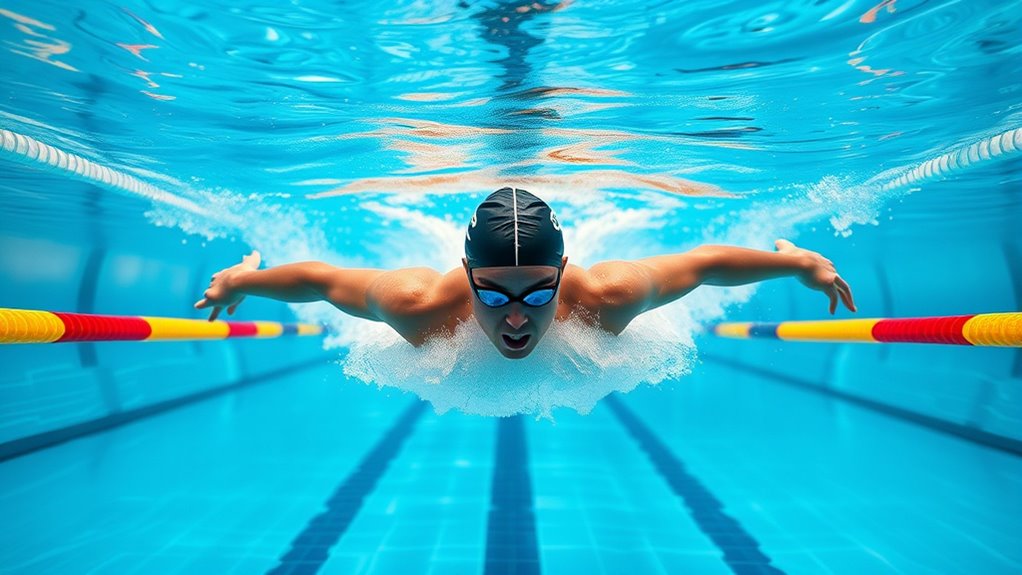
Designing effective drills is essential for refining your swimming technique and making the most of your training time. Focus on specific skills you want to improve, such as stroke efficiency, kick strength, or breathing patterns. Break down complex movements into manageable parts and create drills that isolate each component. For example, use pull buoys to emphasize arm positioning or paddles to enhance feel for the water. Keep drills purposeful; avoid unnecessary repetition or fatigue-inducing exercises. Incorporate variety to challenge different muscles and prevent boredom. Adjust intensity and duration based on your skill level and goals. By intentionally designing drills that target your weaknesses and reinforce good habits, you’ll accelerate your progress and develop a more effective and efficient swim technique.
Focusing on Body Position and Alignment
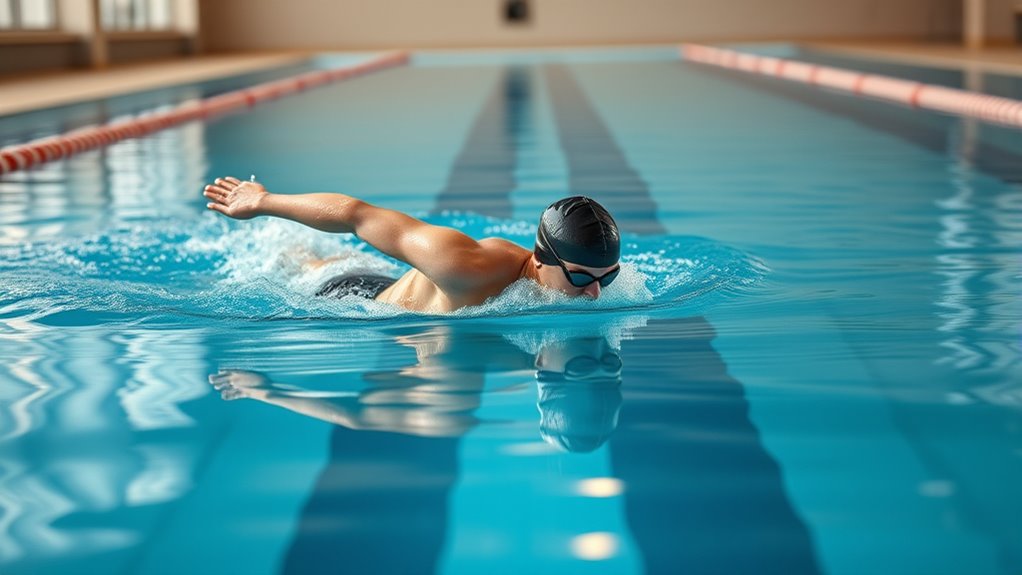
Maintaining proper body position and alignment is essential for swimming efficiently and reducing drag. When your body stays horizontal and streamlined, you cut through the water more easily, conserving energy. Focus on keeping your head in line with your spine, looking down slightly to avoid lifting your chin. Engage your core to stabilize your hips and legs, preventing them from sinking. Your arms should extend forward smoothly, with elbows high during pulls to ensure ideal alignment. Regularly check your body position in the pool or mirror, making small adjustments as needed. Proper alignment minimizes resistance and allows you to move forward with less effort. Consistently practicing body awareness helps develop muscle memory, making good positioning second nature during your swim.
Improving Breathing Patterns and Rhythm
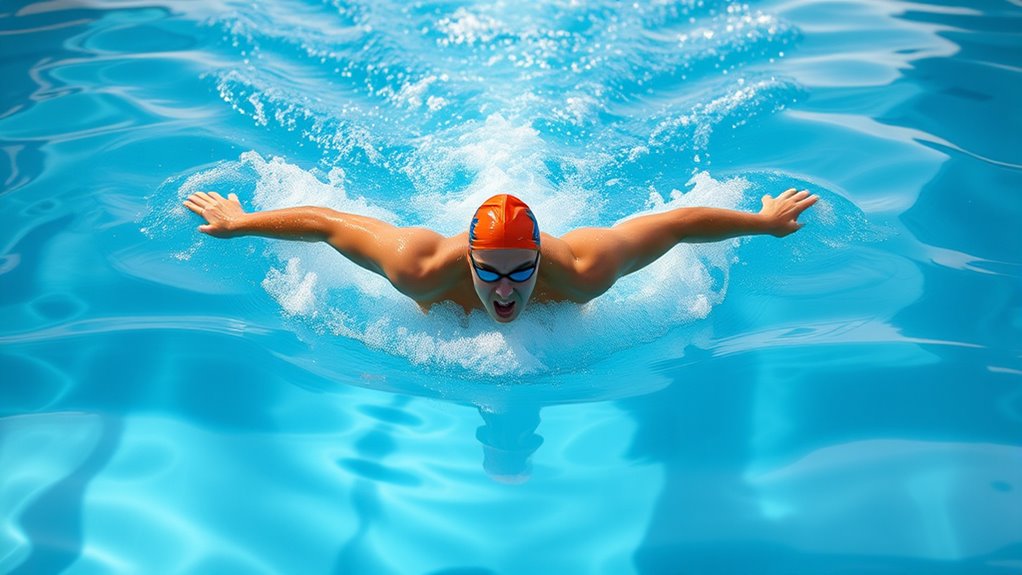
Improving your breathing patterns and rhythm is essential for maintaining endurance and efficiency in the water. Proper breathing helps you stay relaxed, conserve energy, and swim smoothly. To optimize your breathing, try these techniques:
- Establish a consistent rhythm—inhale every 3 or 5 strokes—to develop a steady pattern that feels natural.
- Focus on exhaling fully underwater—this prevents rushing your inhale and reduces panic or breathlessness.
- Practice bilateral breathing—alternating sides during drills ensures balanced muscle development and better coordination.
- Utilizing proper contrast ratio settings in your training environment can help improve visual focus and comfort during swim sessions.
Use your endless pool to set a fixed pace, monitor your breathing, and make adjustments. With consistent practice, your breathing will become more automatic, helping you swim longer and more efficiently without losing rhythm or endurance.
Developing Strong Pulls and Kick Mechanics
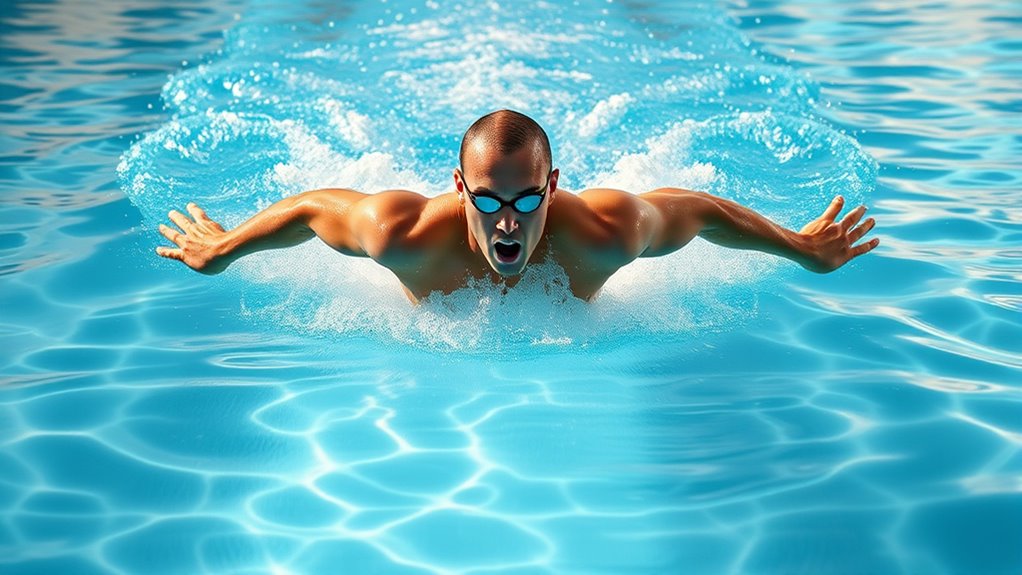
Building strong pull and kick mechanics is essential for maximizing your swimming efficiency and power. Focus on engaging your core to maintain stability and transfer force effectively. For pulls, use a high elbow catch, pulling water past your hips with a smooth, controlled motion. Keep your hand cupped and fingertips pointed downward, minimizing drag. When kicking, drive from your hips rather than your knees, maintaining a steady, rhythmic flutter. Keep your ankles relaxed to improve propulsion and reduce resistance. Incorporate drills that emphasize these elements, such as single-arm pulls or kick sets with a kickboard. Consistently practicing proper pull and kick techniques builds muscle memory, helping you generate more force with less effort and enhancing overall speed and endurance. Additionally, understanding regional legal resources can help you access expert guidance for training and injury prevention strategies.
Incorporating Interval Training for Endurance and Speed

Incorporating interval training into your swim routine is one of the most effective ways to boost both endurance and speed. It pushes your limits, helping you swim faster and longer over time. To get started, consider these key strategies:
Interval training boosts swim endurance and speed by pushing limits and promoting continuous improvement.
- Break your workout into sets of high-intensity swims followed by rest or low-intensity recovery.
- Vary the distances and speeds within each interval to challenge your body and prevent plateaus.
- Track your progress regularly to adjust intensity and duration, ensuring continuous improvement.
- Understanding your personality traits can help tailor your training approach for better motivation and consistency.
Using Feedback and Video Analysis for Self-Correction
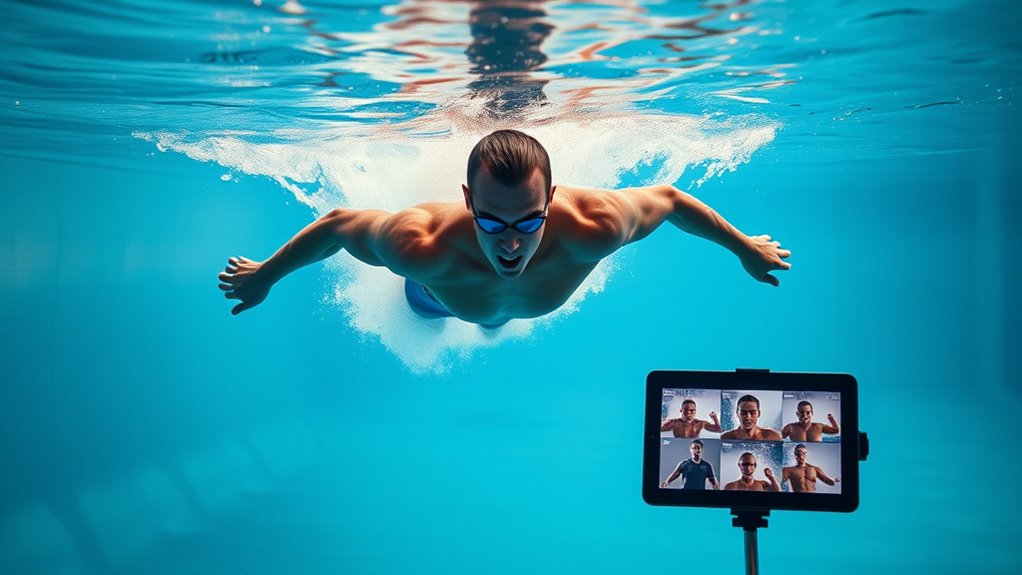
Using feedback and video analysis allows you to identify subtle technical flaws that might go unnoticed during your swim. By recording your strokes, you can observe details like hand entry, body position, and breathing patterns objectively. Watching these videos helps you see inconsistencies between how you feel and how you actually perform, providing valuable insights for correction. Immediate feedback enables you to make adjustments on the spot or during your next session, accelerating your progress. Use slow-motion playback to analyze specific moments and pinpoint issues like misaligned body posture or inefficient arm movement. Consistently reviewing your technique builds awareness and reinforces proper form. Incorporating professional equipment can further enhance the quality of your recordings and analysis. Over time, this self-awareness leads to more efficient, effective strokes and improves your overall swim performance.
Customizing Drills to Address Specific Weaknesses
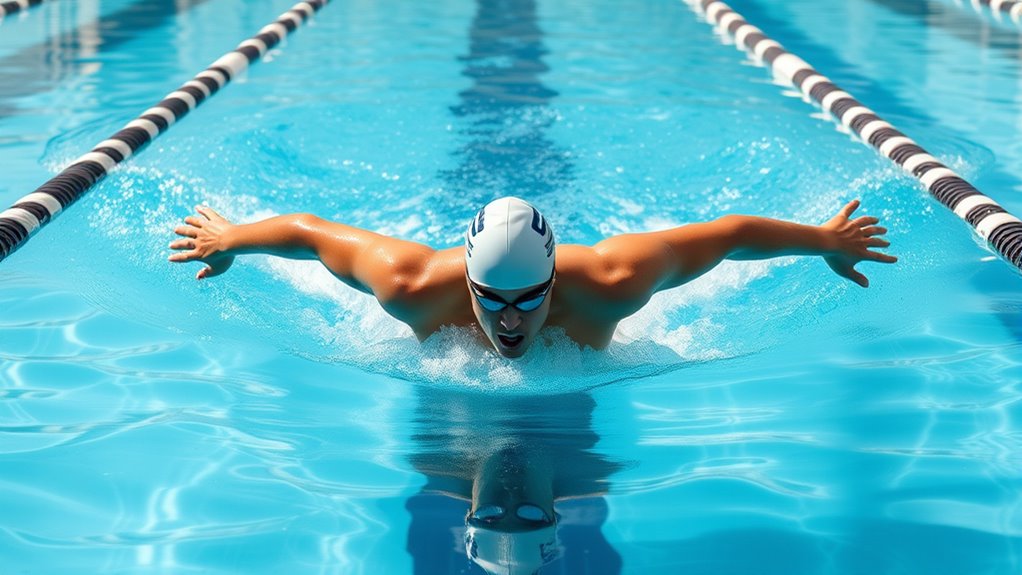
After reviewing your video footage and pinpointing specific technical flaws, tailored drills can directly target those weaknesses. Customizing your drills makes your practice more efficient and effective. Incorporating electric bikes into your training routine can also help improve your overall endurance and stamina for swimming. Consider these approaches:
- Focus on body position: Use drills that emphasize maintaining a streamlined posture to reduce drag.
- Improve stroke timing: Incorporate drills that isolate arm movement and breathing rhythm to enhance coordination.
- Strengthen kick technique: Practice kick sets that target propulsion and stability, addressing weak or inconsistent kicks.
Tracking Progress and Adjusting Your Routine
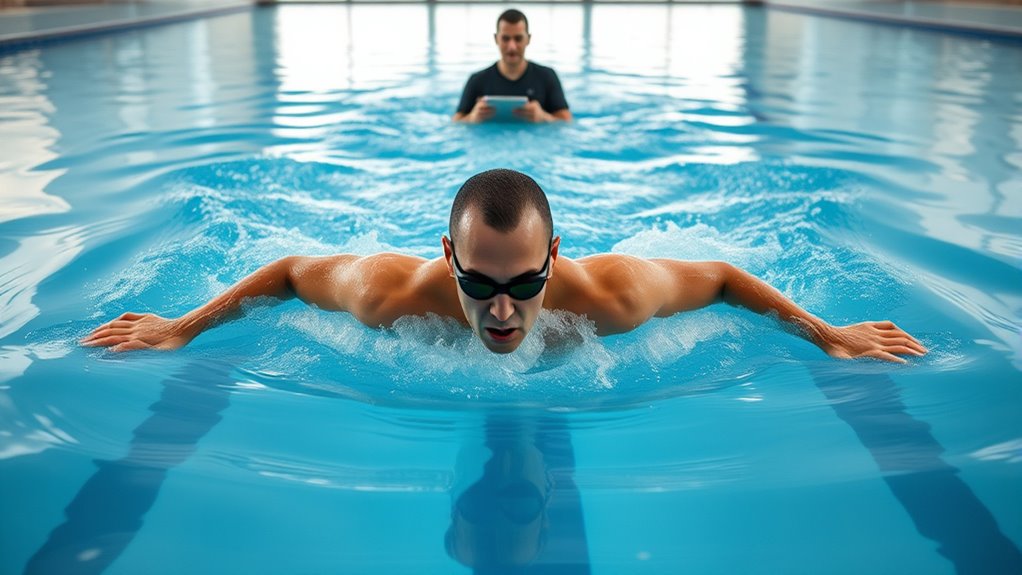
Tracking your progress is essential to guaranteeing your training stays effective and aligned with your goals. Regularly monitor your performance by noting improvements in technique, speed, and endurance. Use a training journal or app to record each session, including drills completed and personal observations. This helps you identify patterns, strengths, and areas needing more focus. As you track your progress, don’t hesitate to adjust your routine—add new drills, increase intensity, or modify rest periods to keep challenging yourself. Consistent evaluation keeps you motivated and prevents stagnation. Remember, small, steady improvements add up over time. By staying attentive to your progress and making informed adjustments, you ensure your training remains purposeful, effective, and aligned with your ultimate swimming goals.
Frequently Asked Questions
Can Beginners Safely Use an Endless Pool Without Prior Instruction?
Yes, beginners can safely use an endless pool without prior instruction, but it’s crucial to take precautions. You should start slowly, familiarize yourself with the controls, and stay close to the edge for safety. If possible, have a knowledgeable person nearby to guide you. Consider taking a basic swim safety course first, especially if you’re new to swimming, to guarantee you understand water safety principles and proper techniques.
What Are Some Common Mistakes to Avoid During Technique Drills?
You should avoid overextending your strokes, which can cause fatigue and poor form. Don’t rush through drills; focus on maintaining proper technique and steady breathing. Be mindful of your body position, keeping it streamlined to reduce drag. Avoid neglecting warm-up and cool-down periods, as skipping these can increase injury risk. Ultimately, don’t ignore feedback from instructors or recordings—use it to refine your movements and prevent ingraining bad habits.
How Often Should I Update or Change My Training Drills?
You should update your training drills every 4 to 6 weeks, like changing the sails on a boat to catch new winds. This keeps your muscles guessing and prevents plateaus. Listen to your body’s signals—if you notice stagnation or boredom, it’s time for a fresh set of drills. Consistent variation fuels progress, ensuring your technique stays sharp and your motivation remains high.
Are There Specific Drills Recommended for Open Water Swimming Skills?
Yes, there are specific drills you should try for open water swimming skills. Practice sighting drills to improve navigation, simulate waves and currents with side or head turns, and work on drafting behind a swimmer to conserve energy. Incorporate breathing exercises to handle unpredictable conditions and practice turning and sighting while maintaining your pace. These drills help build confidence and adaptability, making your open water swims safer and more efficient.
How Can I Incorporate Strength Training Alongside Pool Drills?
You can incorporate strength training alongside pool drills by scheduling dedicated sessions focusing on core, upper body, and leg exercises. Use resistance bands, weights, or body-weight moves like push-ups and squats to build muscle. To maximize effectiveness, align your strength workouts with your swim training, ensuring recovery days. This integrated approach boosts power and endurance, translating into more efficient swimming and better performance in open water.
Conclusion
By consistently practicing with your endless pool, you unlock your true potential—like a sculptor chiseling away to reveal the masterpiece within. Stay patient, focus on technique, and let each drill be a step toward mastery. Remember, progress isn’t just about speed; it’s about transforming your form. Embrace the journey, for every stroke you refine brings you closer to your best self in the water’s quiet mirror.
